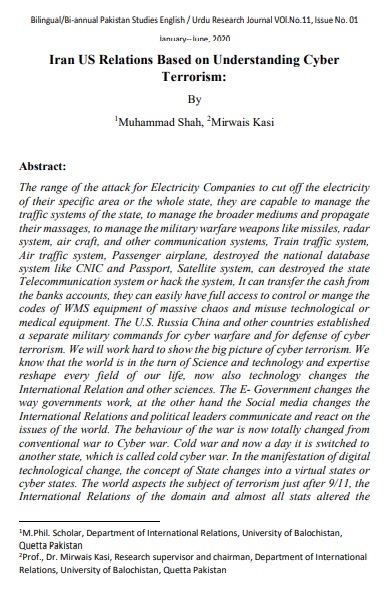Iran US Relations Based on Understanding Cyber Terrorism:
Keywords:
Understanding, Cyber Crime, Telecommunication System, Cyber War etc.Abstract
The range of the attack for Electricity Companies to cut off the electricity
of their specific area or the whole state, they are capable to manage the
traffic systems of the state, to manage the broader mediums and propagate
their massages, to manage the military warfare weapons like missiles, radar
system, air craft, and other communication systems, Train traffic system,
Air traffic system, Passenger airplane, destroyed the national database
system like CNIC and Passport, Satellite system, can destroyed the state
Telecommunication system or hack the system, It can transfer the cash from
the banks accounts, they can easily have full access to control or mange the
codes of WMS equipment of massive chaos and misuse technological or
medical equipment. The U.S. Russia China and other countries established
a separate military commands for cyber warfare and for defense of cyber
terrorism. We will work hard to show the big picture of cyber terrorism. We
know that the world is in the turn of Science and technology and expertise
reshape every field of our life, now also technology changes the
International Relation and other sciences. The E- Government changes the
way governments work, at the other hand the Social media changes the
International Relations and political leaders communicate and react on the
issues of the world. The behaviour of the war is now totally changed from
conventional war to Cyber war. Cold war and now a day it is switched to
another state, which is called cold cyber war. In the manifestation of digital
technological change, the concept of State changes into a virtual states or
cyber states. The world aspects the subject of terrorism just after 9/11, the
International Relations of the domain and almost all stats altered the foreign policies due to savage, terrorism issues and this terrorism now
changed to cyber terrorism and it altered the frame work of the
International Relation to challenge the cyber terrorism. We cover all the
above discussion in this thesis
References
A Conversation With Admiral J Michael Mcconnell. (n.d.). Retrieved
october 26, 2018 from
https://wn.com/a_conversation__with_admiral_j_michael_mcconn
ell
Aboul Enein, S. (2016). Report of the group of governmental experts on
developments in the field of information and telecommunications in
the context of international security.
Awan, I. (2014). Debating the Term Cyber-Terrorism: Issues and Problems.
Internet Journal of Criminology, 6743, 1–14.
Bakshi, A., & Yogesh, B. (2010). Securing cloud from ddos attacks using
intrusion detection system in virtual machine. In Communication
Software and Networks, 2010. ICCSN’10. Second International
Conference on (pp. 260–264).
Brezina, T. (1996). Adapting to strain: An examination of delinquent coping
responses. Criminology, 34(1), 39–60.
Conway, M. (2006). Terrorism and the Internet: New media—New threat?
Parliamentary Affairs, 59(2), 283–298.
Correia, M., & Andr, F. (2009). D EP S KY : Dependable and Secure
Storage in a Cloud-of-Clouds, 31–45.
Eriksson, J., & Giacomello, G. (2007). International relations and security
in the digital age. International Politics. Routledge.
http://doi.org/10.4324/9780203964736
Farwell, J. P., & Rohozinski, R. (2011). Stuxnet and the Future of Cyber
War. Survival, 53(1), 23–40.
http://doi.org/10.1080/00396338.2011.555586
Hughes, R. (2009). Towards a global regime for cyber warfare. Cryptology
and Information Security Series, 3, 106–117.
http://doi.org/10.3233/978-1-60750-060-5-106
Impact of Alleged Russian Cyber Attacks. (n.d.). Retrieved from
http://www.dtic.mil/dtic/tr/fulltext/u2/a504991.pdf
Roberts, L. (2008). Jurisdictional and definitional concerns with computermediated Interpersonal crimes: An Analysis on Cyber Stalking.
International Journal of Cyber Criminology, 2(1).
Romano, C. P. R. (2000). The peaceful settlement of international
environmental disputes: A pragmatic approach. Kluwer Law
International, The Hague(Netherlands). 410, 2000.
Slack, C., & Slack, C. (2016). Wired yet Disconnected : The Governance of
International Cyber Relations, 7(1), 69–78.
http://doi.org/10.1111/1758-5899.12268
Toregas, C., & Zahn, N. (2014). Insurance for Cyber Attacks: The Issue of
Setting Premiums in Context, 20. Retrieved from
https://www.seas.gwu.edu/~cspri/s/cyberinsurance_paper_pdf.pdf
United States of America, Plaintiff-appellee, v. Rajib K. Mitra, Defendantappellant, 405 F.3d 492 (7th Cir. 2005) :: Justia. (n.d.). Retrieved
October 26, 2018, from
https://law.justia.com/cases/federal/appellatecourts/F3/405/492/473548/
University Information Technology Services. (2010). Data Center Access
Policies and Procedures, 1–9.
Warikoo, A. (2014). Proposed Methodology for Cyber Criminal Profiling.
Information Security Journal: A Global Perspective, 23(4–6), 172–
http://doi.org/10.1080/19393555.2014.931491
Weimann, G. (2004). www. terror. net: How modern terrorism uses the
Internet (Vol. 116). DIANE Publishing.
Yar, M. (2013). Cybercrime and society. Sage.
Yunos, Z., Ahmad, R., & Mohd Sabri, N. A. (2015a). A Qualitative
Analysis for Evaluating a Cyber Terrorism Framework in Malaysia.
Information Security Journal: A Global Perspective, 3555(May), 1–
http://doi.org/10.1080/19393555.2014.998844
Yunos, Z., Ahmad, R., & Mohd Sabri, N. A. (2015b). A Qualitative
Analysis for Evaluating a Cyber Terrorism Framework in Malaysia.
Information Security Journal: A Global Perspective, 3555(May), 1–
http://doi.org/10.1080/19393555.2014.998844
Zhou, M., Zhang, R., Zeng, D., & Qian, W. (2010). Services in the Cloud
Computing Era : A Survey



